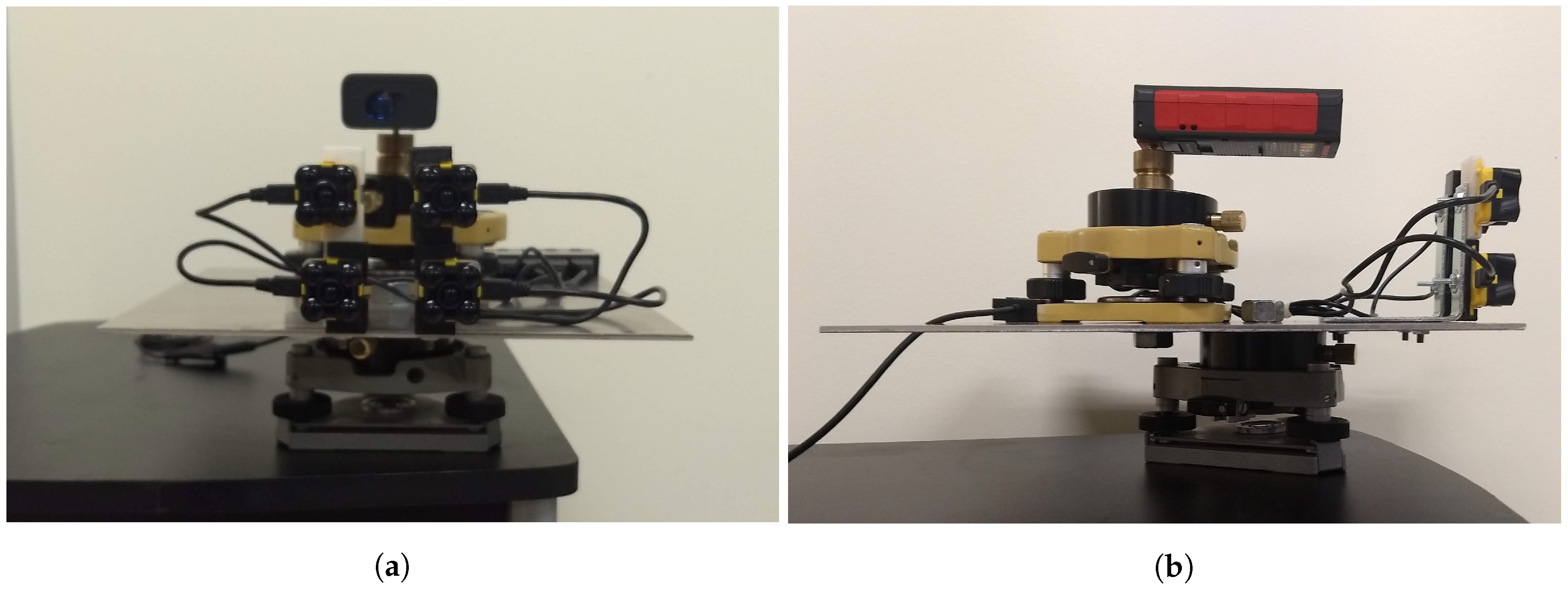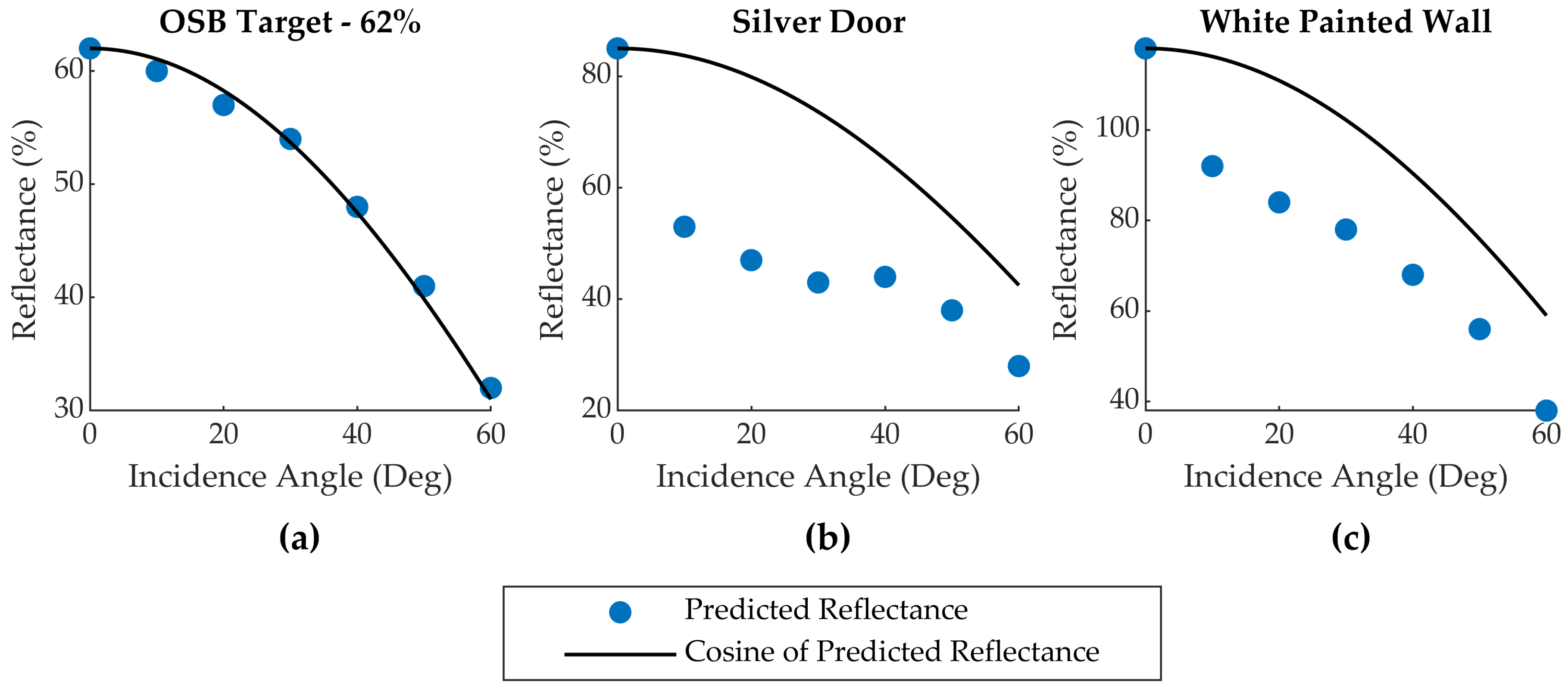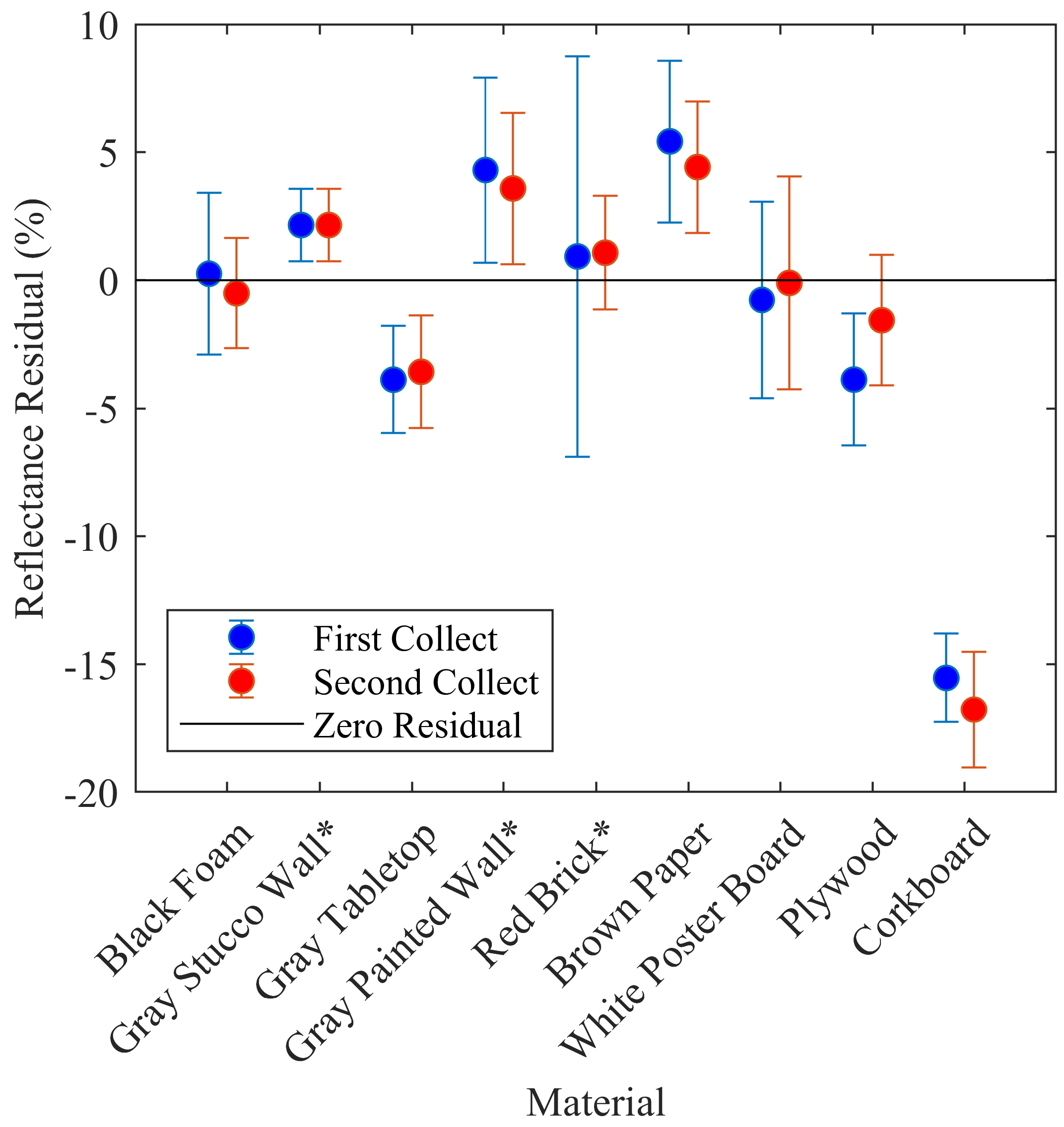2.1. Lidar Radiometric Calibration
For a traditional, laser-based lidar sensor, the power received,
, by the sensor is related to the physical characteristics of the illuminated target, acquisition geometry, the atmospheric environment, and system characteristics. This relationship, often termed the lidar range equation, is given in [
14] as:
where
is the transmitted power,
is the diameter of the receiver aperture,
R is the target range,
is the laser beam width,
is the system transmission factor,
is the atmospheric transmission factor, and
is the target cross section given as:
where
is the solid angle of scattering,
is target reflectance, and
is the target area.
Under the assumptions of a Lambertian target that intercepts the entirety of the transmitted power, a negligible atmospheric transmission factor due to short ranges, constant system parameters, and normal target incidence, Equations (
1) and (
2) can be combined and simplified to:
where
is a calibration parameter containing constant terms from Equations (
1) and (
2). See [
14] for a step-by-step derivation of how the assumptions noted above lead to this simplified form of the lidar range equation. Solving for target reflectance and inverting the value within
leads to:
Thus, under reasonable simplification, target reflectance is proportional to received optical power and target range. If one or more targets of known reflectance are observed, the calibration constant,
, can be computed and target reflectance can be estimated for subsequent lidar measurements where both target range and return signal power measurements are reported.
Equations (1)–(4) assume that the return signal power measurement is linear with respect to the actual power incident on the sensor. This characteristic is common among airborne lidar sensors, and the above equations can be used to radiometrically calibrate these sensors [
4,
14]. However, in contrast to airborne lidar, terrestrial lidar sensors must observe both very close and distant targets. Their response to such a broad range of returned optical power can be non-linear, and a single calibration constant (
) may not be sufficient. However, their system parameters are still constant, and therefore their reported return signal intensities vary smoothly, although non-linearly, with the amount of received optical power. Thus, empirical functions or interpolation from look up tables (LUTs) can be used to model the relationship between target reflectance and the reported target range and intensity [
5,
15].
For the ITOF-based Evo 60 m lidar sensor examined in this paper, the system parameters are not constant—the integration time is variable. This negates the ability to use a physical model with a single calibration constant, or the use of a single empirical functional approximation or LUT. We observed 12 different integration times in our work with the Evo 60 m, which would require 12 values for assuming the sensor has a linear response, or 12 functional approximations or LUTs for a nonlinear sensor. Experimentation with generating unique values for each integration time did not produce stable results, suggesting a non-linear sensor response. Comparisons of range, amplitude, and ambient light values of measurements having a common integration time also yielded complex relationships not easily modeled with functions or LUTs. These observations motivate our pursuit of an empirical approximation in the form of a simple neural network that is capable of estimating target reflectance values from measurement data that spans all integration times.
2.2. Indirect Time of Flight
Although not required for understanding the proposed radiometric calibration method, we briefly review the ITOF ranging technique. Radiometric calibration of lidar intensity is primarily of interest to the remote sensing community, which is most familiar with pulsed time of flight and traditional phase difference lidar techniques, and a review will provide context to the work herein.
An ITOF lidar sensor continuously emits amplitude modulated light, similar to traditional laser-based phase difference lidar sensors. However, instead of measuring phase delay through direct comparison or mixing of the return signal with a version of the emitted signal, ITOF relies on quadrature sampling of the return energy [
16,
17]. The amount of return energy is integrated four times per period, i.e., at 90-degree phase intervals (see
Figure 1), the timing of which is aligned with the phase of the emitted signal. The measure of phase of the return signal,
, is thus the phase delay between the emitted and return signal and is computed from the integrated quadrature energy samples as:
where
through
are the quadrature samples of integrated return energy. Target range is then calculated using the standard equation for phase difference lidar:
where
c is the speed of light and
f is the frequency of the modulating wave. Note that, as with traditional continuous wave phase difference lidar, the maximum unambiguous target range is half the length of the modulating wavelength.
The amplitude, or intensity,
A, of the return signal can also be computed from the integrated signal measurements as:
Finally, the background light,
B, which is the sum of ambient light and the DC component of the attenuated light reflected back from the target, is calculated as:
For the Evo 60 m, the integration time automatically increases when observing low reflectance targets, i.e., when the return energy is low. Although the exact details are unknown, a reasonable conjecture—based on the observation that the rate at which the measurements are reported decreases with increasing integration times—is that that multiple quadrature measurements are summed to improve the signal to noise ratio. Thus, as has been observed, reported amplitude measurements can sometimes increase when observing successively lower reflectance targets at the same range.












